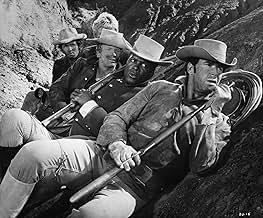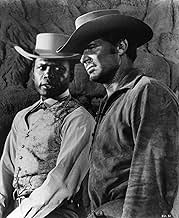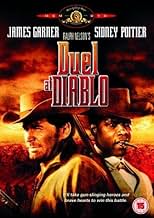VALUTAZIONE IMDb
6,5/10
4665
LA TUA VALUTAZIONE
Nel territorio di Apache, un uomo cerca l'assassino della moglie indiana e una casalinga abbandona il marito per raggiungere la tribù del suo amante Apache.Nel territorio di Apache, un uomo cerca l'assassino della moglie indiana e una casalinga abbandona il marito per raggiungere la tribù del suo amante Apache.Nel territorio di Apache, un uomo cerca l'assassino della moglie indiana e una casalinga abbandona il marito per raggiungere la tribù del suo amante Apache.
- Regia
- Sceneggiatura
- Star
- Premi
- 1 candidatura in totale
Ralph Nelson
- Col. Foster
- (as Alf Elson)
Armand Alzamora
- Ramirez
- (non citato nei titoli originali)
Ralph Bahnsen
- Trooper Nyles
- (non citato nei titoli originali)
Timothy Carey
- Deputy Clem
- (non citato nei titoli originali)
Jeff Cooper
- Trooper Casey
- (non citato nei titoli originali)
Kevin Coughlin
- Norton
- (non citato nei titoli originali)
Robert Crawford Jr.
- Trooper Swenson - Bugler
- (non citato nei titoli originali)
Recensioni in evidenza
Caught between Hollywood's traditional western genre and the revisionist western styles of the late 1960s and 1970s, Duel at Diablo seems both a little behind and ahead of its time. As an old-fashioned western, Duel at Diablo has traditional cavalry vs. Indian story line and well-executed, exciting battle scenes. Beyond this, the film also addresses racism and oppression towards native Americans in a complex and non-sentimental manner, through various inter-linked sub-plots. While the Apaches may be cruel and the instigators of attacks, it is clear that this is only because they have been oppressed to the point where they have no other resort. This is not a battle between "good guys" and "bad guys" and in the end nobody wins. Perhaps, the film could have delved a little deeper into the social and ethical issues it raises. At times, it appears that the movie itself is unsure whether it is primarily an action film or a message film. However, this is also the movie's strength as its messages do not detract from the story and action, and never appear simplistic or preachy as is often the case in westerns that take a sympathetic perspective on the plight of native Americans.
Meanwhile, the excellent, rhythmic and moody musical score by Neil Hefti, while unusual for a western, is well suited to accompanying the unrelenting action sequences and conveying the tragedy and doom of a society and individuals caught in a vicious cycle of conflict and racism. The casting of the film further contributes to making Duel a Diablo a strong, atypical western. James Garner, who up to then had always played amiable leading men, sheds his typical persona to effectively portray a tough and rugged frontier scout, bent on avenging the murder of his Indian wife. Equally effective and very cool-looking in a 3-piece suit, Sidney Poitier is an army sergeant turned businessman, whose color is on the surface only incidental to the story beyond a couple of subtle inuendos (that said, it is really left to the viewer's interpretation whether his race is significant to the story, and it is somewhat ironic to see a black man taking charge among a regiment of white soldiers in shoot-outs against Indians). Europeans Bibi Anderson and Bill Travers also seem strangely out of place, respectively portraying what could be a Scandinivian emigrant and a Scottish-born American officer. And Dennis Weaver, who up to that time was mainly known as a simple good guy in TV's Gunsmoke plays the part of a nuanced villain. Add to this the beautiful cinematography of wide desert landscapes, and Duel at Diablo is a superior, exciting, and socially-conscious western, not a great one, but certainly unique.
in an age when black actors were confined to black roles, this film shows Poitier in a role that could easily have been played by a white actor-plus he's the coolest dude in the movie.
Bill Travers doesn't have to do an American accent.
this was from a time that people believed that there could be major characters with foreign accents in the USA who weren't villains.
Of course the USA at this time, and at any time, had plenty of odd accents. Except in movies.
The credits are waaaay more imaginative that you'd normally expect.
The music is highly "different" The camera-work is very strange- all those overhead shots.
I love this movie, and is a film I can watch again and again. It's very stylised-the lines are delivered like they were from a comic book.
You know-the sort of thing Quentin T "discovered"
Bill Travers doesn't have to do an American accent.
this was from a time that people believed that there could be major characters with foreign accents in the USA who weren't villains.
Of course the USA at this time, and at any time, had plenty of odd accents. Except in movies.
The credits are waaaay more imaginative that you'd normally expect.
The music is highly "different" The camera-work is very strange- all those overhead shots.
I love this movie, and is a film I can watch again and again. It's very stylised-the lines are delivered like they were from a comic book.
You know-the sort of thing Quentin T "discovered"
I first saw this movie as a small child on television, and twenty-two years later I finally got the guts to rent it last week to revisit it, and to see why I was so interested in it then. I recalled the exciting cavalry charges etc. and I even remembered the opening refrain of the strange musical score. I really enjoyed this movie unlike most of my childhood favorites. While the movie itself is alot like a John Ford Cavalry opera, it plays out alot differently. This one has more in common with the modern action movie, I think, than with most B-westerns of the 1960's. The fast pace of the movie, unearthly fates of the dead, anti-heroism of the protagonist (James Garner), and well done scenes of horse-borne combat combine to create a Western-Adventure-Morality Play that I certainly recommend. There are multiple forces at play here. Among them the bizarre, scorched desert scenery, Garner's quest for revenge for his dead Indian wife while pining over the married woman disgraced by her captivity with the Apaches, The underlying loyalty of Poitier's former soldier character to his former comrades (despite his overtly self-serving statements) contrasted with the underlying self-promoting purposes of Bill Traver's role as military commander. Too, I see shades of this one in 1993's Geronimo by Walter Hill (burning vistas, Apaches hidden in the ground, Garner's Remsberg character in Duval's Al Seiber etc.) The musical score is off-beat for standard western fare, but who needs more drum beats, flutes, and rattles?! I think the score compliments the movie well, and is perhaps the best indicator that this production thinks outside of the box, even if it remains within it subjectively. This may not qualify as a classic, but I definitely think its a great action flick, and a breath of western fresh air with intriguing insights into race, warfare, culture, and the winning of the west.
James Garner is a good lead in this rousing Cavalry v. Indians western. There are very good battle scenes between between the outnumbered soldiers and the attacking Indians. The underlying issues of prejudice add an interesting touch to the movie as well with James Garner's character struggling with the death of his Indian wife and the Bibi Andersson character struggling with raising her baby fathered by an Indian brave.
As in any good western, the scenery also plays an important part and the southern Utah settings are particularly striking. The musical soundtrack is a little off-beat for a western, but also very good. Dennis Weaver, Sidney Poitier, and Bill Travers all add to the movie with good supporting performances.
As in any good western, the scenery also plays an important part and the southern Utah settings are particularly striking. The musical soundtrack is a little off-beat for a western, but also very good. Dennis Weaver, Sidney Poitier, and Bill Travers all add to the movie with good supporting performances.
A bloody, brutal Western where the action never stops.
First, the Bad (let's get that out of the way). Like all Westerns, the plot has its flaws -- with an Indian war party off the reservation they would not have sent a shipment of ammunition through a narrow canyon guarded by only one squad of green recruits on unbroken/partly saddle broken horses. But so what? In the classic Western Stagecoach the Indians would have shot the horses pulling the stage and then finished off the passengers as opposed to shooting at the people in the coach. Also, Sidney Poitier's silver vest remains immaculate throughout the long desert journey and several pitched battles.
However, the movie moves so fast that you never really have time to stop and remind yourself that you have to "suspend disbelief" to watch it.
Next, the Good. On one level, it's a classic cavalry vs. Indians story. But viewed through a different lens than in earlier Westerns; the Indians are shown with some perspective, if not total sympathy, which probably makes this one of the first Westerns to get beyond a one dimensional view of them. There are a variety of interesting subplots which flesh out the major characters and keep things twisting, turning, and moving along between the combat scenes. In fact, almost every one of the characters is angry about something, creating lots of tension between them. James Garner's character is looking for the men who raped and killed his (Indian) wife, Dennis Weaver's Will Grange is angry about almost everything, including that his wife was held captive by the Indians, Sidney Poitier's Toller (now a civilian) is mad that circumstances forced him to accompany the cavalry on this mission ....
Garner and Poitier give excellent performances and the other actors rise to the occasion, helping us forget that they are, in fact, Scottish or Danish.
At the end of the movie the various subplots are tied up and the issues are resolved with (in one case) a very surprising twist.
On top of that, you have a wonderful (almost superb, for this movie) Neal Hefti score, which always seems to correctly reflect the mood of the scene. It fits the movie even better because it makes heavy use of Western/military instruments: guitars, horns, drums, ....
Finally, the Ugly. There are some fairly graphic scenes here (although not exactly like in the Wild Bunch or Saving Private Ryan). The Apaches could torture with the best of them and some of that appears in this movie, although we're spared the close-ups.
All in all, I must say that this is one of my long time favorites. I hope you enjoy it as much as I do!!
First, the Bad (let's get that out of the way). Like all Westerns, the plot has its flaws -- with an Indian war party off the reservation they would not have sent a shipment of ammunition through a narrow canyon guarded by only one squad of green recruits on unbroken/partly saddle broken horses. But so what? In the classic Western Stagecoach the Indians would have shot the horses pulling the stage and then finished off the passengers as opposed to shooting at the people in the coach. Also, Sidney Poitier's silver vest remains immaculate throughout the long desert journey and several pitched battles.
However, the movie moves so fast that you never really have time to stop and remind yourself that you have to "suspend disbelief" to watch it.
Next, the Good. On one level, it's a classic cavalry vs. Indians story. But viewed through a different lens than in earlier Westerns; the Indians are shown with some perspective, if not total sympathy, which probably makes this one of the first Westerns to get beyond a one dimensional view of them. There are a variety of interesting subplots which flesh out the major characters and keep things twisting, turning, and moving along between the combat scenes. In fact, almost every one of the characters is angry about something, creating lots of tension between them. James Garner's character is looking for the men who raped and killed his (Indian) wife, Dennis Weaver's Will Grange is angry about almost everything, including that his wife was held captive by the Indians, Sidney Poitier's Toller (now a civilian) is mad that circumstances forced him to accompany the cavalry on this mission ....
Garner and Poitier give excellent performances and the other actors rise to the occasion, helping us forget that they are, in fact, Scottish or Danish.
At the end of the movie the various subplots are tied up and the issues are resolved with (in one case) a very surprising twist.
On top of that, you have a wonderful (almost superb, for this movie) Neal Hefti score, which always seems to correctly reflect the mood of the scene. It fits the movie even better because it makes heavy use of Western/military instruments: guitars, horns, drums, ....
Finally, the Ugly. There are some fairly graphic scenes here (although not exactly like in the Wild Bunch or Saving Private Ryan). The Apaches could torture with the best of them and some of that appears in this movie, although we're spared the close-ups.
All in all, I must say that this is one of my long time favorites. I hope you enjoy it as much as I do!!
Lo sapevi?
- QuizJames Garner's first western since leaving Maverick (1957) and Sidney Poitier's first theatrical western.
- BlooperAs Willard hands his wife a gun, he says there are two cartridges in gun. However, it can be seen that all six chambers are loaded.
Bullet noses can be seen in the chambers on the left side of the cylinder but a minute or so later, the right side is on camera and shows 3 empty chambers.
- Citazioni
Ellen Grange: They all think that any decent woman would prefer to die than live as an Apache squaw. Maybe they're right.
Jess Remsberg: Death comes soon enough. Anyone who hurries it is a damn fool.
- Curiosità sui creditiThe United Artists logo is sliced off the screen with a bloody Calvary Saber, slicing an "X" across the screen, revealing the opening scene. At the end, the same saber slices the live picture away, as (sort of) a fade out.
- ConnessioniFeatured in Rubare alla mafia è un suicidio (1972)
I più visti
Accedi per valutare e creare un elenco di titoli salvati per ottenere consigli personalizzati
- How long is Duel at Diablo?Powered by Alexa
Dettagli
- Tempo di esecuzione
- 1h 43min(103 min)
- Colore
- Proporzioni
- 1.66 : 1
Contribuisci a questa pagina
Suggerisci una modifica o aggiungi i contenuti mancanti





































